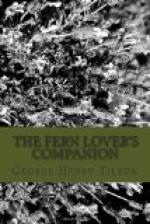[Illustration: Rusty Woodsia, Woodsia ilvensis]
The rusty Woodsia is decidedly a rock-loving fern, and often grows on high cliffs exposed to the sun; its rootstock and fronds are covered with silver-white, hair-like scales, especially underneath. These scales turn brown in age, whence the name, rusty. As the short stipes separate at the joints from the rootstock, they leave at the base a thick stubble, which serves to identify the fern. Exposed rocks, Labrador to North Carolina and westward. Rather common in New England. Said to be very abundant on the trap rock hillocks about Little Falls, N.J., where it grows in dense tufts.
(2) NORTHERN WOODSIA. ALPINE WOODSIA
Woodsia alpina. Woodsia hyperborea
Fronds narrowly lanceolate, two to six inches long, smooth above, somewhat hairy beneath, pinnate. Pinnae triangular-ovate, obtuse, lobed, the lobes few and nearly entire. Fruit-dots rarely confluent. Indusium as in Woodsia ilvensis.
[Illustration: Details of Northern Woodsia. Woodsia alpina]
Thought by some botanists to be a smooth form of Woodsia ilvensis. It was discovered in the United States by Horace Mann, in 1863, at Willoughby Lake, Vt. Twenty years or more later it was collected by C.H. Peck in the Adirondacks, who supposed it to be Woodsia glabella. In 1897 it was rediscovered at Willoughby Lake by C.H. Pringle. New York, Vermont, Maine, and British America. Rare.
[Illustration: Northern Woodsia, Woodsia alpina (From Waters’ “Ferns,” Henry Holt & Co.)]
(3) BLUNT-LOBED WOODSIA. Woodsia obtusa
Fronds broadly lanceolate, ten to eighteen inches long, nearly twice pinnate, often minutely glandular. Pinnae rather remote, triangular-ovate or oblong, pinnately parted into obtuse, oblong, toothed segments. Veins forked. Fruit-dots on or near the margin of the lobes. Indusium conspicuous, at length splitting into several spreading, jagged lobes.
[Illustration: Blunt-lobed Woodsia. Woodsia obtusa]
This is our most common species of Woodsia and it has a wider range than the others, extending from Maine and Nova Scotia to Georgia and westward. On rocky banks and cliffs. The sori of this species have a peculiar beauty on account of the star-shaped indusium, as it splits into fragments. Var. angusta is a form with very narrow fronds and pinnae. Highlands, New York. The type grows in Middlesex County, Mass., but is rare.
(4) SMOOTH WOODSIA. Woodsia glabella
Fronds two to five inches high, very delicate, linear, pinnate. Pinnae remote at the base, roundish-ovate, very obtuse with a few crenate lobes. Stipes jointed, straw-colored. Hairs of the indusium few and minute.
[Illustration: Smooth Woodsia. Woodsia glabella (Willoughhy Mountain, Vt. G.H.T.)]




